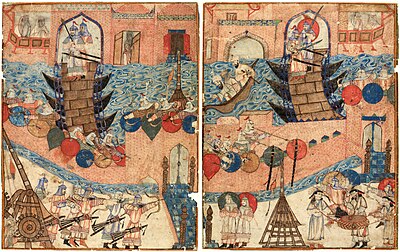
Back الغزو المغولي لخوارزم Arabic لەشکرکێشی مەغۆلەکان بۆ سەر ئێران CKB حمله مغول به ایران Persian ایران اُتے منگول حملہ PNB பாரசீகம் மீதான மங்கோலியப் படையெடுப்பு Tamil İran ve Mezopotamya’nın Moğollar tarafından istilası Turkish ایران پر منگول حملہ Urdu Moʻgʻullarning Forsga bosqini Uzbek
| Mongol conquest of Persia & Mesopotamia | |||||||||
|---|---|---|---|---|---|---|---|---|---|
| Part of the Mongol invasions and conquests | |||||||||
 The Siege of Baghdad, in which the Mongols decisively secured their hegemony over Mesopotamia | |||||||||
| |||||||||
| Belligerents | |||||||||
| Mongol Empire | |||||||||
| Commanders and leaders | |||||||||
| Casualties and losses | |||||||||
| Unknown | Heavy | ||||||||
The Mongol conquest of Persia comprised three Mongol campaigns against Islamic states in the Middle East and Central Asia between 1219 and 1258. These campaigns led to the termination of the Khwarazmian dynasty, the Nizari Ismaili state, and the Abbasid Caliphate of Baghdad, and the establishment of the Mongol Ilkhanate government in their place in Persia.
Genghis Khan had unified the Mongolic peoples and conquered the Western Xia dynasty in the late 12th and early 13th centuries. After a series of diplomatic provocations on the part of Muhammad II, the ruler of the neighbouring Khwarazmian Empire, the Mongols launched an invasion in 1219. The invaders laid waste to the Transoxianan cities of Bukhara, Samarkand, and Gurganj in turn, before obliterating the region of Khorasan, slaughtering the inhabitants of Herat, Nishapur, and Merv, three of the largest cities in the world. Muhammad died destitute on an island in the Caspian Sea. His son and successor, Jalal al-Din, tried to resist the Mongols, but was eventually defeated and forced into exile. Genghis returned to his campaign against the Jin dynasty in 1223, only retaining governance of the northern Khwarazmian regions.
The war had been one of the bloodiest in human history, with total casualties estimated to be between two and fifteen million people. The next three decades saw conflicts of lesser scale but equal destruction in the region. Soon after his accession to the khaganate in 1227, Ögedei Khan sent an army under Chormaqan Noyan to end Jalal al-Din's resistance and subjugate several minor polities in Persia. This was carried out gradually: al-Din was killed in 1231, with Isfahan and Maragheh being besieged and captured the same year; Irbil was captured in 1234; and Georgia was gradually subjugated and vassalised before Chormaqan's death in 1241. Several other Persian towns and cities, such as Hamadan, Ray, and Ardabil, were also captured by the Mongols.
The final stage began in 1254. On the orders of his brother, the Khagan Möngke Khan, Hulagu Khan systematically captured the fortresses of the Nizari Ismaili state in northern Persia, seizing their capital of Alamut in 1256. In 1258, Hulagu then marched on the Abbasid Caliphate of Baghdad; capturing the city, he ended the 500-year-old Abbasid dynasty by killing the caliph Al-Musta'sim, marking the end of the Islamic Golden Age. Persia would later become the heartland of the Mongol Ilkhanate.
© MMXXIII Rich X Search. We shall prevail. All rights reserved. Rich X Search